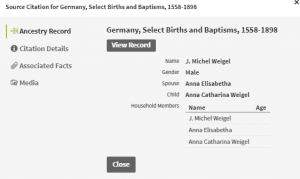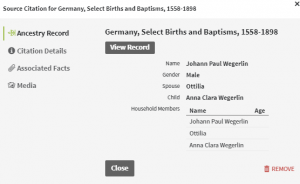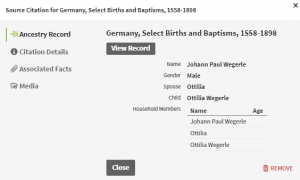The name Weigel has a long and complicated history. According to some sources it dates back to medieval times and belong to a prominent family that played a large part in shaping European history.
First let’s start with what we know. We know, thanks to our research into Zacharias there are several ways to spell the Weigel family name, which would in time many many years later become the Wegley family in America. Here are just some of the ways people have spelled the Wegley name over the years.
- Wegley (1900s)
- Weighley (1800s)
- Weigley (1700s)
- Wageli (1600s)
- Weigel (1600s)
- Weichel (1500s)
- Weigle
- Van Veigle
- Weagley
- Wegerlin
- Wagerline
- Wegerle
- Weygell
- Weigele
- Wegerle
- Weckerly
- Freigley (obvious typo)
Silesia is located in the historical region that is now in southwestern Poland. This is where we are told is the first recorded use of the Weigel name. You can view the map here.
The Weigel family was very well established in this area. Then at some point at history they migrated to other places, perhaps due to the political unrest going on in the Silesia area.
At one time they Weigel’s were one family so we can assume it was during this time in Silesia, but that again is not confirmed data so take it for what you will.
Eventually the family separated and branches settled in different places. We know of three main branches of the family. There are the Bavarian Weigls, Saxon Weigels, and further north, along the Baltic Sea, the name appeared as Weigele.
The Bavarian and Saxon Weigels preoccupied themselves mostly with matters of religion and in printing and publishing books. The Bavarian Weigls remained Catholics, but some of the Saxon Weigels became followers of the Lutheran religion.
Valentin Weigel was born on August 07, 1533 in Hayn and died on June 10, 1588 in Zschopau.
He was a German theologian, philosopher and mystical writer, and an important precursor of later theosophy. In English he is often called Valentine Weigel. Valentin Weigel, who was of the Saxon branch of the family, is also been referred to as “Der Grosse (Great) Herder”.
He was born at Hayn, near Dresden, into a Catholic family. Now I should point out that there are other sources which say he was born in Naundorf near Grossenhain – this I tend to believe more because it is in Saxony and well Valentin was of the Saxon branch of the Weigel family, so wouldn’t it make sense that he was born in Saxony, instead of in Hayn, some 118 miles away?
That issue aside, what we do know that in 1533 the Weigel family of the Saxon branch were still Catholic. However that obviously changed because in 1567 he became a Lutheran pastor at Zschopau, near Chemnitz. So now we know that sometime between 1533 and 1567 the Saxon branch of the family went from Catholics to Lutherans. We don’t know why, or the exact dates.
We also know that he studied at Meissen, Leipzig, and Wittenberg. And after becoming a Lutheran pastor in Zschopau at the age of 34, he lived out a quiet life, engaged in his writings. He would spend the rest of his life in Zschopau and would eventually die there in 1588 at the age of 55. I wondered how old the average person lived to be in the 1500s and found out that the peasantry could expect to live to be about 40-45 years while nobility would average 50 years and anything beyond that was considered fairly ancient. So in terms of the sixteen century, Valentin Weigel lived to be an old man.
Valentin Weigel was best known for his belief that the Virgin Mary was herself the product of a virgin birth. He based his belief on the idea of the immaculate conception, which required that Mary must also be sinless in order to bear God in the flesh. He kept his ideas secret, entrusting them only to personal friends. He carried out his parishioner duties in the Lutheran church and kept a low profile.
But all the while he had very profound beliefs that he documented extensively. When he died he left around 6000 pages in printed or manuscript works.
His ideas on human nature were only gradually and posthumously published. Johann Arndt, Gottfried Arnold, and Gottfried Leibniz helped to spread Weigel’s ideas. His mysticism was marked by that of Johannes Tauler and by doctrines of Paracelsus; he was also a follower of Sebastian Franck and Caspar Schwenckfeldt. Like these two latter, he emphasized the inner life. He advocated a “spiritual church” in which one could know Christ without books or scripture. When he died, his followers spread his word and those followers were called the “Weigelaner.”
Valentin Weigel emphasized the necessity of internal unction (an anointing of Spirit; see 1 John 2:20) and illumination. He taught … that knowledge does not come from without, but from the Spirit operating upon our spirit within. In cosmology, Valentin Weigel stands near Paracelsus … (After his death), his writings were published in various places, and Weigelanism became widely spread. His opponents represented him (falsely) as a dangerous revolutionary who aimed at the overthrow of all political and social order.”
Valentin Weigel’s father was Michael Weigel. At least one sort lists Michael’s wife as Anna Katrina Van Veigle, but the English translation of Katrina is Catherine. Also, in German, a “v” is prounounced as a “w”, so that would account for the spelling of her last name. However this information may not be accurate. There is also – Michael Johannes HABLUZEL and Anna Katherina Van Veigle (1750 – 1820) so if this is the person they speak of then Anna Katherina couldn’t be his mother because she was born way after his death. It is worth mentioning however due to the unique spelling of the name.
More About Johannes Michael Hablutzel:
Census: 1764, Colonial America 1607-1789 Pennsylvania Census Index.
Estate Inventory: May 03, 1796, Woodford County Will Book B 1796-1807.
Immigration: 1764, Sailed from Rotterdam on the Ship Chance.
Marriage: Catherine Weigle 1770, Pennslyvania. / Johannes married 1, 3, 6 Anna Katrina Van Veigle (Weigle) “Caty” in 1780 in , Westmoreland County, Pennsylvania, United States.
Anna Katrina Van Viegle
Catherine Weigle
Anna Katherina Van Veigle
Anna K. Van Veigle (Weigel)
Anna Catherine Weigel
Anna Catherina Weigle
Anna Katrina “Caty” Van Veigle (Weigle)



You must be logged in to post a comment.